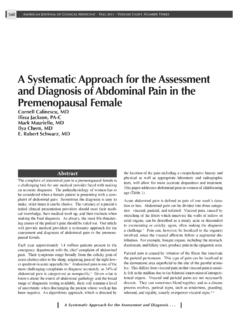Transcription of Molar Pregnancy and other Gestational Trophoblastic …
1 27. Molar Pregnancy and other Gestational Trophoblastic Diseases Heleen van Beekhuizen INTRODUCTION chromosome pattern. Often a fetus or fetal tissue is present. Only 2% of partial moles develop into Gestational Trophoblastic disease (GTD) is a placen- invasive moles1. tal disease: it arises from abnormal proliferation of Trophoblastic cells in the placenta. When GTD. INCIDENCE. persists or recurs it is often called Gestational tropho- blastic neoplasm (GTN). The spectrum of GTD Molar pregnancies are rare: approximately 1 in includes: every 400 800 pregnancies is a complete or partial Complete and partial hydatidiform Molar preg- Molar Pregnancy . Choriocarcinoma and persistent nancies: the most common form of GTD inva- Trophoblastic neoplasm are even rarer with an sive mole (GTN). incidence of approximately 1 : 50,000 pregnancies. Choriocarcinoma, placental site Trophoblastic Risk factors for GTD are: tumor (PSTT) and epithelioid Trophoblastic Teenage pregnancies tumor (ETT) which are all malignant degenera- Pregnancies in women above the age of 35 years tions of placental tissue.
2 Very rarely no antecedent History of Molar Pregnancy : the risk of recur- Pregnancy can be identified. PSTT and ETT are rence is 1% after one Molar Pregnancy and rare and are not discussed further in this book. 15 20% after two Molar pregnancies1. Most, but not all GTD produce -human chorio- Smoking nic gonadotropin (hCG), which is also produced in Blood group A, B or AB. normal pregnancies and can be detected with a Nulliparity urine Pregnancy test (UPT). Use of oral contraceptives (no higher chance in persistent/invasive mole). Complete mole History of infertility. This is the most frequent form (80% of GTD). Its chromosomal pattern is mostly 46XX and all SIGNS AND SYMPTOMS. chromosomes are paternal: often an empty' ovum Early signs and symptoms of GTD are severe is fertilized by a single sperm that duplicates, but hyperemesis, vaginal blood loss in first trimester of sometimes two sperm cells fertilize an empty'.
3 Pregnancy , anemia, rapid growth of the uterus and ovum. No fetus is present in a complete Molar early pre-eclampsia (before 20 weeks' gestation). Pregnancy . In 15 20% of the complete hydatidi- Abdomen distention may be a sign of theca-lutein form moles, the Trophoblastic tissue persists and cysts or ascites; some women have respiratory fail- causes persistent/invasive mole or choriocarcinoma. ure or seizures (due to eclampsia or brain meta- stasis). In a number of women small grape-like Partial mole particles are born vaginally. Five per cent of women In partial mole, two sperm cells fertilize a normal present with hyperthyroidism; hCG has thyroid- ovum resulting in a 69 XYY, XXX or XXY stimulating activity. 337. GYNECOLOGY FOR LESS-RESOURCED LOCATIONS. In partial moles these symptoms are less pro- Histological examination from suspicious abor- nounced as the hCG levels are lower compared to tion tissue is the most reliable investigation and complete moles.
4 Should always be carried out if abortion tissue looks abnormal. In settings where histology is impossible EXAMINATION it is advisable to do a UPT 4 weeks after evacuation with suspicious tissue. When the UPT is positive 4. The uterus is enlarged for the Gestational age and weeks post-evacuation, a GTD should be suspected very soft on bimanual palpation. Sometimes there and follow-up of UPT for 12 months is recom- is some dilatation of the cervical os or the grape- mended (see paragraph on follow-up). like particles may be visible during speculum exam- As chemotherapy may be required, in these ination. A vaginal metastasis can be present. patients HIV status needs to be determined as well On vaginal examination metastasis in the vagina as CD4 count, as chemotherapy treatment will be can be palpated. One needs to stress that vaginal complicated in patients with poor immunity and a examinations should be gently performed and once CD4 count < 2003.
5 Anti-retroviral therapy can be metastases are found in the vagina no further exam- administered concurrently with chemotherapy. inations should be allowed since torrential hemor- rhage can occur. Remember the vaginal metastases are like icebergs. A small component is found above TREATMENT. the surface with a much bigger volume of disease Suction evacuation is the treatment of choice (level subepithelial. of evidence 2C). This can be done by both con- ventional suction curettage as well as by manual INVESTIGATIONS. vacuum aspiration (MVA) and preferably should On ultrasound in complete moles a classical picture take place in a hospital with blood transfusion of a snowstorm' is seen. No fetus or amniotic fluid possibilities and ideally with an intensive care unit is present. Often in the ovaries enlarged theca- (ICU) department as Trophoblastic embolization lutein cysts are present (detection rate is 56%2).
6 During evacuation is an emergency requiring venti- During vaginal ultrasound look for invasion into lation and must be differentiated from cardiac fail- the myometrium and/or adnexa. In these situa- ure, thyroid storm, and acute respiratory distress tions, the risk of uterine perforation and severe syndrome (ARDS). Be prepared for massive blood bleeding may occur if one tries to evacuate a uterus. loss [cross-match at least 2 units of blood, have 2. Some regard these patients as having invasive Molar intravenous (IV) drips running] and if you use pregnancies and it may be safer to give them MVA have at least two MVA sets and one or two chemotherapy as for choriocarcinomas. assistants who empty the syringes all the time for In partial Molar pregnancies the ultrasound diag- you, so you can act fast in order to minimize blood nosis is more complicated: cystic spaces can be seen loss.
7 Use the largest MVA cannula of 12 mm. If the in the placenta (Swiss cheese appearance). Some- uterus becomes more empty, blood loss diminishes, times multiple ovarian cysts are seen; this is caused the uterus feels gritty and some foam is seen in the by hormonal stimulation by hCG of the ovaries. MVA. If possible, check this with ultrasound dur- Often a fetus with or without cardiac activity is ing the procedure. Give oxytocin only at the end present (detection rate of ultrasound is much lower of the procedure when the uterus is empty because than in complete mole). there is some concern that oxytocics given early The hormonal level of -hCG in blood and can lead to persistent GTD. In patients with un- urine is increased (more than two times the controllable vaginal bleeding after suction evacua- median). Measuring the level of -hCG in blood is tion, hemorrhage can be controlled by balloon often not possible in low-resource settings, but tamponade such as with the Bakri balloon (or low- UPT are often available, and may be positive.)
8 Resource adaption: put condom around indwelling However a false-negative UPT can be seen in bladder catheter and fill the condom with several Molar pregnancies; therefore blood -hCG levels hundred milliliters of IV fluid) that is used in post- are the gold standard in diagnosis and follow-up. partum hemorrhages. Sometimes uterine artery It is advisable to do a chest X-ray in patients ligation or hysterectomy is used to stop blood loss. with GTD to exclude lung metastasis. Major complications of evacuation are blood loss 338. Molar Pregnancy and other GTD. and uterine perforation. The patient who has se- Chemoprophylactic drugs are single agent metho- vere bleeding from a vagina metastasis may benefit trexate or dactinomycin and might be appropriate from vaginal packing. Do not try to remove vaginal prophylaxis in women who are difficult to follow- metastasis because this will bleed profusely.
9 Up (Level of evidence 2B). In partial Molar pregnancies it is good practice to give 1000 IU anti-D anti-globulin to Rhesus- Twin pregnancies negative patients if available. In complete Molar In twin pregnancies with one viable fetus and one pregnancies there are no fetal blood cells and this is complete Molar Pregnancy , women might want to not necessary. continue the Pregnancy until term. Pregnancy might be complicated with preterm deliveries, on- Follow-up going vaginal blood loss, early and severe pre- Women should receive reliable anti-conceptives eclampsia and intrauterine fetal death. Around after evacuation of a Molar Pregnancy for at least 19 57% of these women develop GTN requiring 1 year because a new Pregnancy will interfere with (multiple cycles of) chemotherapy. In only 25 40%. follow-up. of these twin pregnancies, will a live baby be born. In resource-rich settings: check serum -hCG.
10 Indications to start chemotherapy4. every second week after evacuation of a Molar Pregnancy until it normalizes, then check it Where -hCG estimation is available, plateau- monthly for 1 year: when plateauing or rising ing or rising hCG GTN. hCG GTN is diagnosed4. Plateaued hCG is In resource-poor settings: positive UPT 4. defined as four successive comparable measure- months after evacuation or earlier if signs of ments of hCG in 3 weeks. Rising hCG is defined Molar Pregnancy re-occur on the ultrasound as two consecutive increases in hCG concentra- Choriocarcinoma tion of 10%. Evidence of metastasis (check vagina and chest In resource-poor settings the only way to detect X-ray as these are the most common sites). recurrence is often UPT and ultrasound. You When serum hCG 20,000 IU/l 4 weeks after can start performing monthly ultrasounds 1 evacuation and when hCG is still present month after evacuation.








